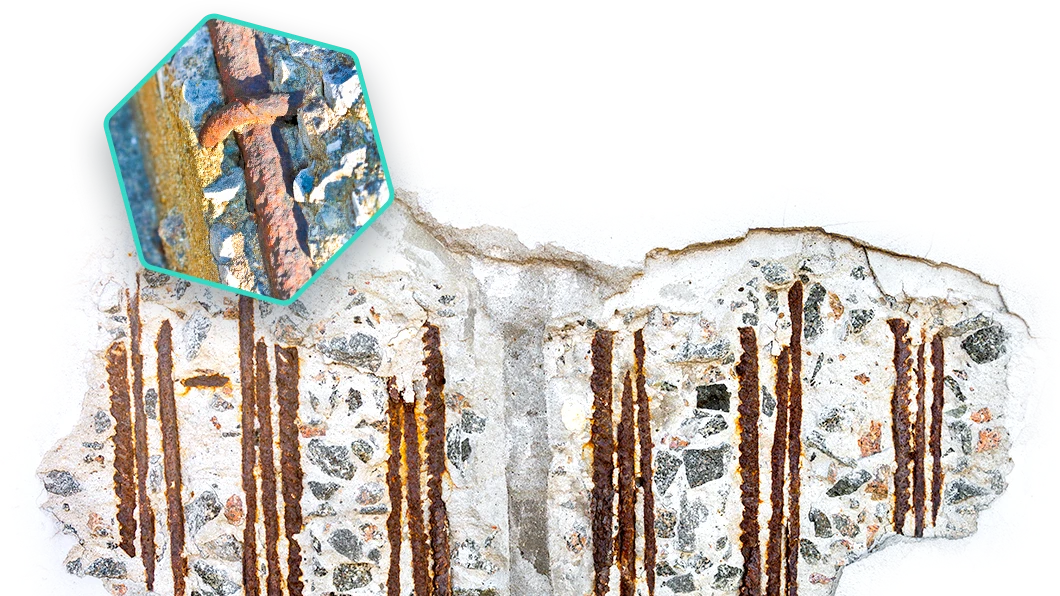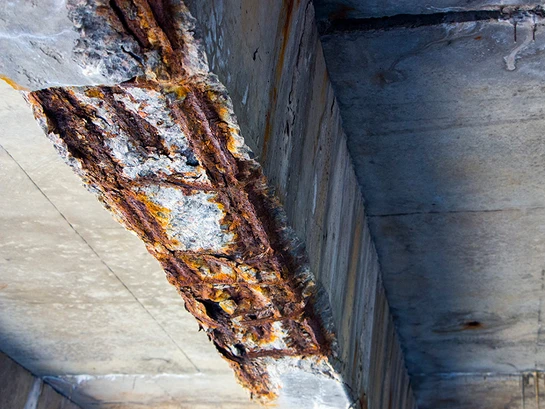What is Corrosion
Noun
The deterioration of a material (usually a metal) that results from a chemical or electrochemical reaction with its environment.
The Corrosion Process
Corrosion in concrete most commonly occurs when chlorides (salt) permeate through the concrete and reach the reinforcing steel. Once the chlorides reach the steel, the process of corrosion starts and corrosion products (rust) begin to form on the surface of the steel. These expansive oxides create tensile stress on the surrounding concrete, leading to cracks, spalls and delaminations. Symptoms of corrosion are not always immediately visible; therefore it’s important to understand what to look for and how to identify it.
How to Identify Corrosion
Determining the levels of concrete contamination and the severity of corrosion damage requires consultation with an expert. However, these symptoms are simple and obvious to see.
-
Rust Bleeding – unsightly brown/orange stains on the concrete indicate the steel has corroded.
-
Cracks – tapping around cracks with a hammer can indicate corrosion. Listen for a hollow sound to identify corrosion damaged areas.
-
Previous Repairs – multiple patch repairs indicates poor concrete health, often caused by corrosion.
-
Spalls & Delaminations – as corrosion continues, pressure on the concrete intensifies. Small or large chunks of concrete can fall off, known as spalls and delaminations.
-
Exposed Rebar – in severe cases, spalls and delaminations can expose the rusted rebar.

What is Cathodic Protection and How Does it Mitigate Corrosion?
In the process of corrosion the steel discharges small electrical currents into the concrete. Cathodic protection consists of countering these discharges with an equal/greater current going in the opposite direction (concrete to rebar), such that the steel rebar does not discharge current any longer. When this is achieved, corrosion is stopped.
For new structures the most effective way to mitigate corrosion is to prevent it. Preventive coatings, high-quality concrete, and galvanized rebar are common preventive methods used for corrosion prevention in new structures. For most owners, this is not an option as their preexisting concrete is already contaminated with corrosive contaminants.
NoCo provides state-of-the-art cathodic protection solutions designed to mitigate corrosion, maintain asset value, extend service life. Our systems are cloud-based and actively monitored, guaranteeing consistent protection.
A Problem Often Ignored
Corrosion itself is very often not addressed at all; instead, people deal with the results of corrosion, such as cracks, spalls or rust bleeds until major restoration or complete replacement is required. It is vital for owners to understand the root cause of their assets’ deterioration, and how best to maximize service life and value.
- Identify
- Diagnose
- Protect


